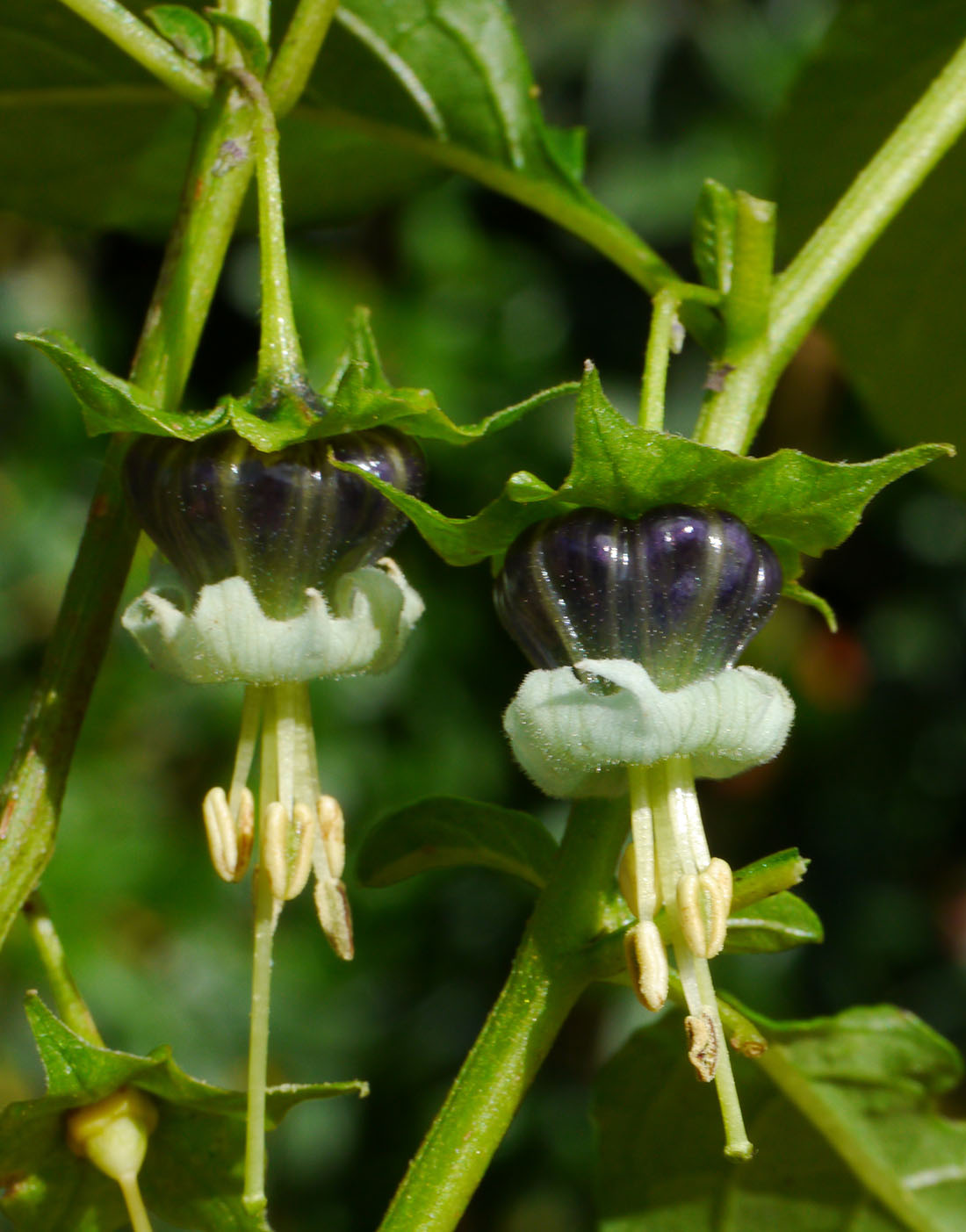
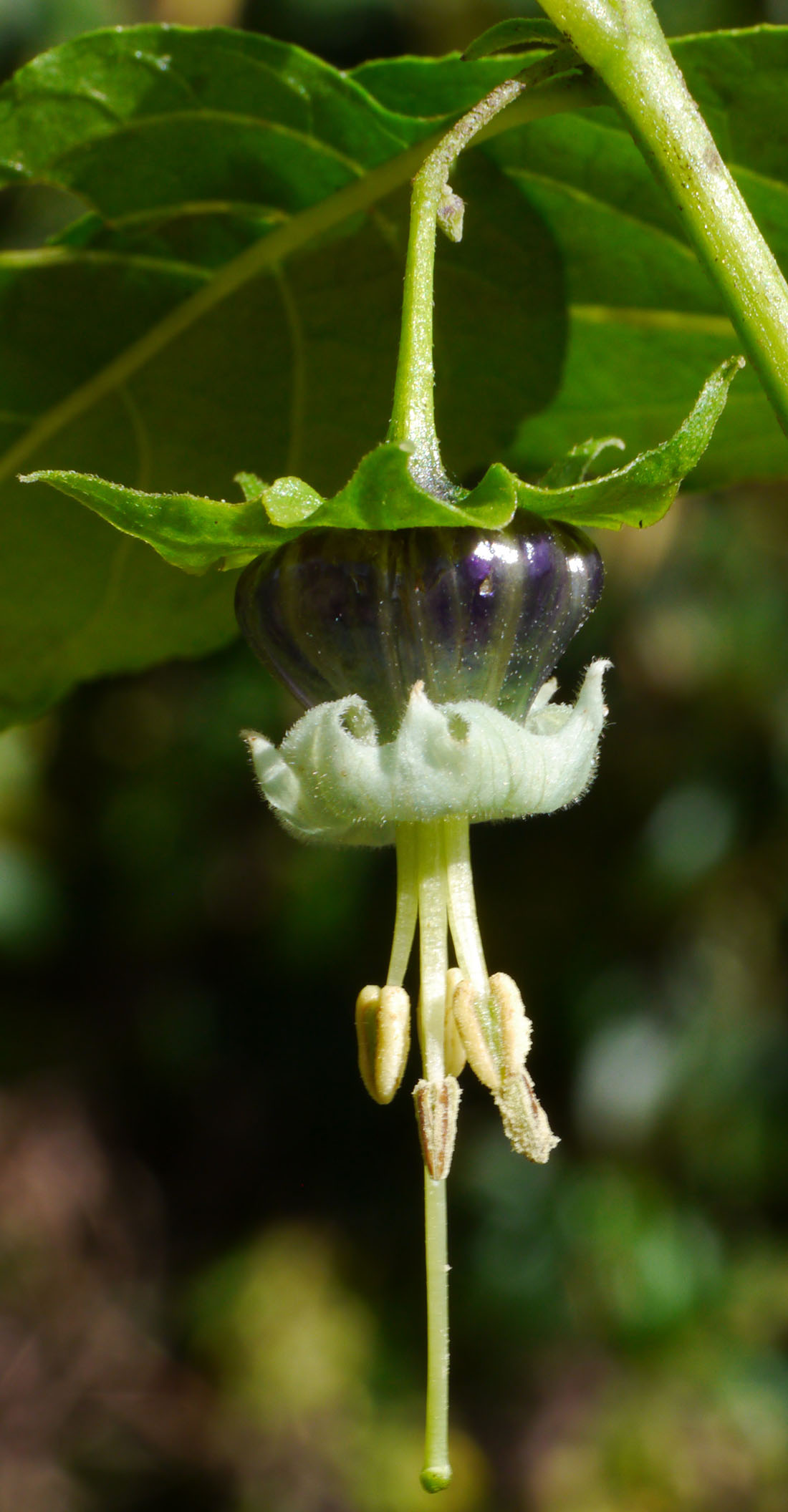
Photo by T. Mione 867 in Peru.
Jaltomata ventricosa (Baker) Mione |
Peru |
revised Aug 2023 |
Link to Jaltomata homepage |
The information on this page may be cited as a personal communication with Thomas Mione (Biology Department, Central Connecticut State Uiversity, New Britain, CT 06050-4010) and Segundo Leiva G. Universidad Privada Antenor Orrego, Av. América Sur 3145, Casilla postal 1075, Trujillo Peru. |
Brittonia 45(2): 138-145. 1993. |
Link to the Jaltomata of La Libertad, Peru |
Link to Jaltomata of northern Peru |
Link to chromosome count |
Link to local names including of this species |
Link to list of Jaltomata species having edible fruits including this species |
Link to table of Jaltomata species having red / orange nectar |
| Figure 1, above. Jaltomata ventricosa flower. Note the ripe or nearly ripe fruit at lower left. All anthers have dehisced. Photo by T. Mione Mione 867 in Peru. |
 |
| Figure 2, above. Jaltomata ventricosa flowers. Note that the anthers of a flower do not dehisce simultaneously. Photo by T. Mione 867 in Peru. |
 |
| Figure 3, above. Jaltomata ventricosa. Note that the anthers of a flower do not dehisce simultaneously and that anthers of the longer stamens dehisced first. Photo by T. Mione 867 in Peru. |
Table 1. Description of Jaltomata ventricosa
| Character | Description | Figures on this page |
Habit & Height |
Erect perennial shrub to 1.5 m high | |
Branches, young |
sparsely to densely pubescent depending on the specimen, the hairs both finger and dendritic all not- gland-tipped | |
older |
glabrate | |
Leaves, size |
blade to 6.5 cm long by 4.5 cm wide; the upper surface bright green | |
| shape | ovate, acute; entire or less commonly sinuate-dentate or toothed with no more than 3 teeth per margin | |
| hairs | hypocotyl and cotyledons of seedlings are pubescent with unpigmented conspicuously gland-tipped finger hairs (Oct 2016, Mione et al. 867) |
|
| petiole | ||
Inflorescence |
usually 1-2 (-4) flowered, sometimes branched on cultivated plants from seed of Leiva 138 but not mentioned in the protologue nor shown in the lectotype. Flowers nodding from 45 degrees below horizontal to pendent. Flower buds triangular when viewed perpendicular to bud's length. |
During the summer of 2017 an outdoor plant of 867 had 4 to 6 flowers per inflorescence, higher than seen previously. However, flowers were not developing properly, for example stamens of flowers of wild plants are exserted (Figures 1, 2, 3) but the flowers on the plant of 867 in the summer of 2017 were not long enough to be exserted. |
peduncle |
4 - 9 mm long; green; terete | |
pedicel |
7 - 16 mm long; always longer than peduncle to which it is attached; green; terete | |
Calyx at flowering |
shiny green abaxially; to 3.4 cm across, lobe radius 9.5-10 mm; sinus radius 3-5 mm. |
"across" means lobe tip to lobe tip |
| shape / position when flowering | rotate | |
| at fruit maturity | Figure 9 | |
Corolla color |
whitish to pale yellow, the base of the flower filling with orange-red nectar visible through the corolla | |
| green spots | no | |
| purple ring | no | |
| purple in base of corolla | yes: the base of the tube pigmented purple | |
shape and size |
the tube urceolate 8-10 mm long; the limb completely and outwardly recurved, 12-14.5 mm diameter | |
lobes/lobules |
10-total, the lobes and lobules alternating, as shown in the bottom left of the lectoype illustration below | |
hairs
|
the throat of the corolla is pilosulose | |
| yes | ||
Stamen length including anther |
13 -- 22 mm on living flowers, 12 -- 19 mm estimated from intact flowers on herbarium specimens |
|
| length stamens exserted beyond distal end of corolla (applicable if corolla has a well-defined tube) | 7 -- 9 mm | |
| base expanded laterally? | Yes, as seen in ventral view | |
| filaments | whitish, slender part pubescent on basal half; the hairs purple, dendritic, to 0.7 mm long | |
| anther color | yellow, the connective green | Figure 10 |
| anther size | undehisced 2.6-3.0 mm long X 2.0-2.2 mm wide; dehisced 2-2.3 mm long, sagittate at base. | |
| anther mucronate / mucronulate | no | originally scored as "no" with field-collected specimen, and confirmed Sept 2017 with cultivated plant of Mione et al. 867 |
| insertion of filament into anther | Directly up and into the anther. |
Figure 10 |
| anthers with temporally staggered dehiscence ? | yes | Mione et al. 712, 867 |
| pollen quantity per flower | ||
| pollen grain size | ||
| corona | no | |
Stigma |
not bilobed, scarcely wider than the style, exserted beyond anthers up to 5 mm |
|
Style |
13.8-15.7 mm long, to 28.5 mm long (Mione et al. 867) |
|
Ovary |
||
Nectar |
Orange-Red | |
| Herkogamy | Yes | |
| Protogyny | Yes | |
Fruit color (at maturity) and size |
orange (based on observations both |
3 |
Seeds per fruit |
59 in pollinator-free greenhouse (one fruit) 57 seeds in one fruit (wild-collected, Mione et al. 867) |
|
Seed Size |
Length: 1.4 - 1.67; Width 1.16 - 1.42; Thickness 0.44 - 0.52 mm |
field-collected seeds |
How long does it take from flower to ripe fruit? |
no data |
|
Ratio of pollen to ovules |
no data |
|
| Character | Description of Jaltomata ventricosa |
| Character | Description | |
Growability in Connecticut, USA |
Did not do well in the heat of the summer but in September outdoor plants looked quite healthy and floriferous |
no data |
How long does it take from flower to ripe fruit? |
no data |
no data |
Flowers Closing For The Night? |
No |
Observation (on Mione et al. 867) by Mione at 9:00 pm in September of 2017 |
Self-Compatible? |
no data |
no data |
Seed Germination |
Seeds planted 6 Sept 2016 first germinated 28 Sept: 22 days until the first above-ground evidence of germination. However, new seedlings were noted/recorded in January and February of 2017, four to nearly five months after seeds were planted. A heat mat was used for about a month, but no heat mat was used after about one month. |
Mione 867 |
| Pollen quantity per flower | ||
Ovules per ovary |
118-181 | n = 3 ovaries |
Ratio of pollen to ovules |
||
Chromosome number |
n = 12 | Mione et al. (1993) |
| Character | Jaltomata ventricosa |
| year | History | |
1870 |
Hebecladus ventricosus Baker was described, without mention of a type locality and without reference to a particular herbarium specimen. The black and white illustration shown on this page (Figure 4) is part of the protologue. The illustration was almost certainly that of a cultivated plant, because at the end of the protologue we can read "It thrives well, cultivated in a cool greenhouse, grown in sandy loam and peat, and allowed plenty of pot room." According to the protologue "Mr. Farris" made the type collection, at least the seeds that were used to grow the plant that was illustrated (below). |
Refugium botanicum; or, figures and descriptions ... 3: t. 208. (Refug. Bot.) |
1962 |
Macbride's description (in English) of H. ventricosus Baker is essentially the same as the description in the protologue. | Flora of Peru. Field Mus. Nat. Hist., Bot. Ser. 13: Part V-B, No. 1. Page 39. |
1992 |
Mione made the new combination Jaltomata ventricosa (Baker) Mione in his doctoral dissertation, and redescribed the species. | Systematics and evolution of Jaltomata (Solanaceae). Ph.D. dissertation, Univeristy of Connecticut Storrs, Connecticut. pages 113 - 115. |
1993 |
The illustration lower on this page (Figure 4) became the lectotype, and the new combination Jaltomata ventricosa (Baker) Mione was validly published. In this paper berries were described as edible, while in the protologue they were described as poisonous. |
Brittonia 45(2): 138 - 145. |
1998 |
Segundo Leiva González illustrated and described (in Spanish) Jaltomata ventricosa (Baker) Mione in his masters thesis. |
Las especies del genero Jaltomata Schlech. (Solanaceae: Solaneae) del norte de Peru. Universidad Nacional Mayor de San Marcos, Escuela de Post-Grado, Facultad de Ciencias Biológicas, Maestría en Botánica Tropical, Lima, Peru, pages 16 - 19. |
2018 |
Segundo Leiva González et al. listed this species (page 720 & 753) as growing in the Shamana archaeological complex |
Arnaldoa 25(2): 703-756. |
Known only from Peru, Department La Libertad, altitude usually 2,900-3,500 m. Flowering Dec., Jan, Feb., May, June. Roadsides, rock walls, and rocky areas.
| Province | Locality | elevation m | habitat | date | collector | Data Entry |
|---|---|---|---|---|---|---|
| Sanchez Carrion* | Near Humachuco | 3,500 |
dry banks, roadside | 3 Dec 1936 | J. West 8193 (GH) | Feb 2007 |
| Sanchez Carrion | in Quebrada del Diablo, ca. 500 m up canyon, a few km SW of Huamachuco, on road to Quiruvilco, 78.05 W, 7.8 S | 3,040 | organic soil among stones, among thorny bushes | 21 Mar 1999 | D. M. Spooner, A. Salas, R. Torres, K. Schüler 7324a (US, WIS) | Nov 2018 |
| Santiago de Chuco | Quiruvilca | 3,963** |
banks of road | "9.1.64" | S. G. E. Saunders 952 (K) | Feb 2007 |
| Otuzco | Tamobamba (handwriting not legible) | 2,700 |
borde de carretera | 13 Nov 1966 | M. Román V. (US) | Sep 2010 |
| Otuzco | Cerro Ragache (Salpo) | 3,200 |
al pié de rocas | 23 May 1984 | A. Sagástegui A. et al. 11574 (MO NY) | Feb 2007 |
| Otuzco | San Miguel (camino Salpo-Samne) | 2,500** |
borde de carretera | 5 June 1990 | S. Leiva & P. Leiva 118 (F HAO) | Feb 2007 |
| Otuzco | Salpo - Shitahuara (Al norte de Salpo) | 3,100 |
cerco de piedras | 15 June 1990 | S. Leiva 138 (F NY); grown for study as Mione 535 | Feb 2007 |
| Otuzco | Cerro de los Enamorados (Al norte de Salpo) | 3,380 |
base de rocas | 12 June 1991 | S. Leiva & P. Leiva 329 (HAO) | Feb 2007 |
| Otuzco | Cerro de los Enamorados (al norte de Salpo) | 3,450 |
ladera | 26 May 1993 | S. Leiva et al. 733 (F, HAO) | Feb 2007 |
| Otuzco | Abajo de San Miguel (ruta a Samne) | 2,900 |
cerco de piedras, en borde de carretera | 27 May 1993 | S. Leiva et al. 743 (HAO) | Feb 2007 |
| Otuzco | Abajo de Shitahuara (al norte de Salpo) | 3,050 |
ladera con abundante arbustos | 15 June 1993 | S. Leiva 788 (HAO NY) | Feb 2007 |
| Otuzco | Agallpampa - Chanchacap | 2,920 |
borde de carretera | 7 Jan 1994 | S. Leiva et al. 961 (HAO) | Feb 2007 |
| Otuzco | Alrededores de Salpo | 3,300 |
borde de chacra | 7 Jan 1994 | S. Leiva et al. 981 (F) | Feb 2007 |
| Otuzco | Shitahuara (al norte de Salpo) | 3,300 |
borde de camino, entre arbustos de Franseria | 13 June 1994 | S. Leiva et al. 1151 (HAO) | Feb 2007 |
| Otuzco | Abajo de Shitahuara (al norte de Salpo) | 3,320 |
cerco de piedras | 13 June 1994 | S. Leiva et al. 1185 (F HAO) | Feb 2007 |
| Otuzco | Base del Cerro Quinga (al este de Salpo) | 3,500 |
borde de carretera | 1 May 1995 | S. Leiva G. 1723 (HAO) | Feb 2007 |
| Otuzco | alrededores de Chota - Motil | 3,300 |
riachuelo entre Rubus robustus, Passiflora peduncula | 8 Feb 1997 | S. Leiva & V. Quipuscoa 1928 (F) | Feb 2007 |
| Otuzco | abajo de San Miguel (ruta Salpo-Samne) | 3,070 |
borde de chacra de Solanum tuberosum | 11 May 1997 | S. Leiva G. 1979 (F) | Feb 2007 |
| Otuzco | in a valley below the big waterfall above town of Yamobamba, 07.98 W, 78.51 S | 2,539 | near stream under trees | 18 March 1999 | D. M. Spooner, A. Salas, R. Torres & K. Schüler 7315b (WIS) | Nov 2018 |
| Otuzco | not recorded in field notebook. We were near the site of collection of J. bernardelloana 640 |
no data |
no data |
11-12 June 1999 | Mione, Leiva & Yacher 641 (only seeds were collect and photo above) |
Feb 2007 |
| Otuzco | Agallpampa. 7 58 56 S, 78 32 54 W | 3,106 |
roadside | 9 June 2005 | Mione, Leiva & Yacher 712 (not pressed, no seeds, photos only) | Feb 2007 |
| Otuzco | Base of Cerro Quinga 8 03 58.5 S, 78 34 28.4 W | 3,755 |
roadside | 21 May 2015 | Mione, Leiva & Yacher 867 (pressed specimen lost); S. Leiva et al. 5900 (HAO) |
Jun 2015 |
* Province not mentioned on specimen, added by Tom Mione. On a map one can see Huamachuco, not the spelling on the herbarium specimen (Humachuco).
** Lowest and highest altitudes recorded.
| Figure 4, above. Jaltomata ventricosa. Back (abaxial face) of calyx to show shape and color of sepal. Photo by T. Mione 867 in Peru. |
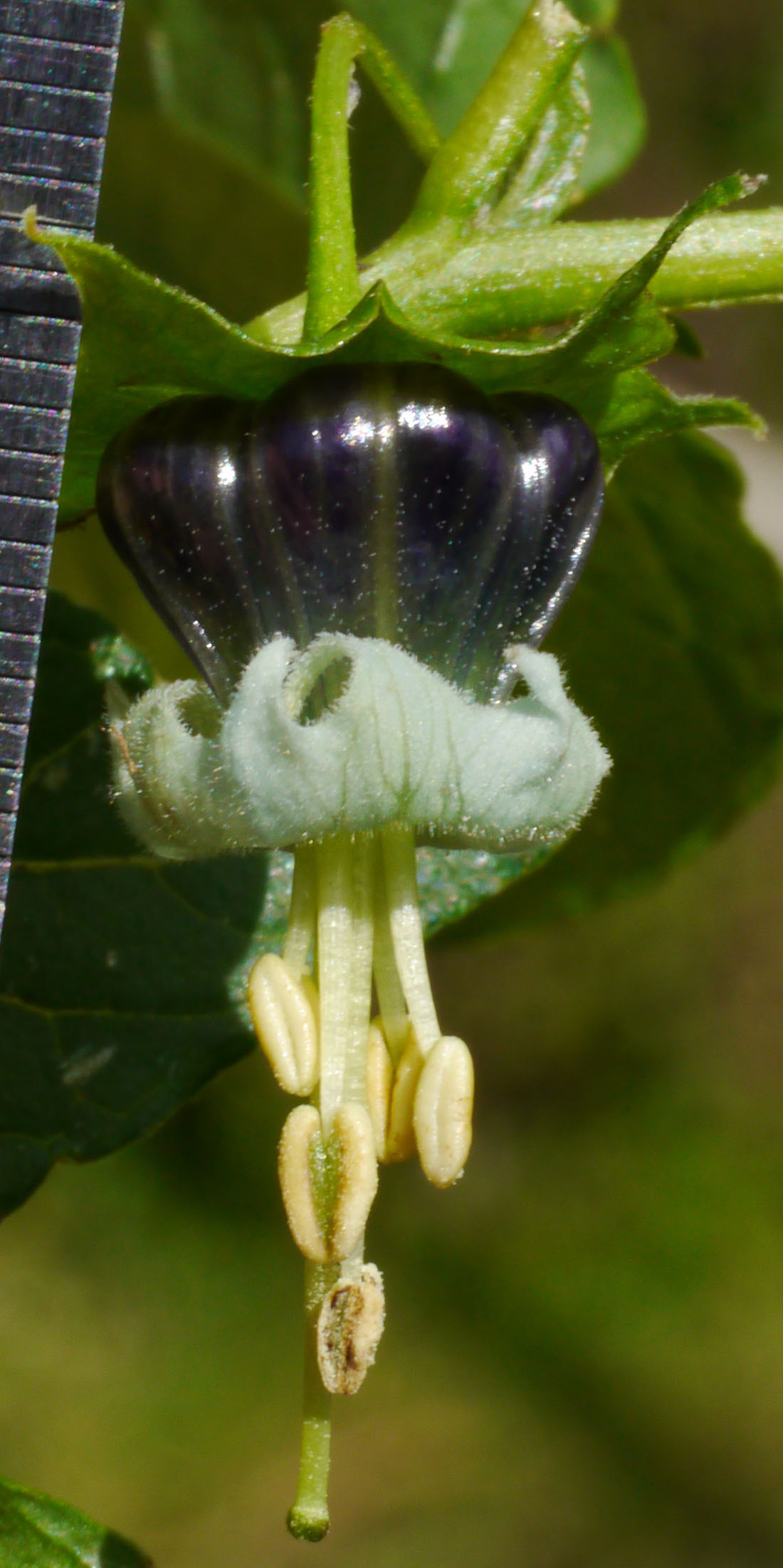 |
| Figure 5, above. Jaltomata ventricosa flower. Note that the anthers of a flower do not dehisce simultaneously. Units on ruler are mm. Photo by T. Mione 867 in Peru. |
Figure 6. Lectotype of Jaltomata ventricosa |
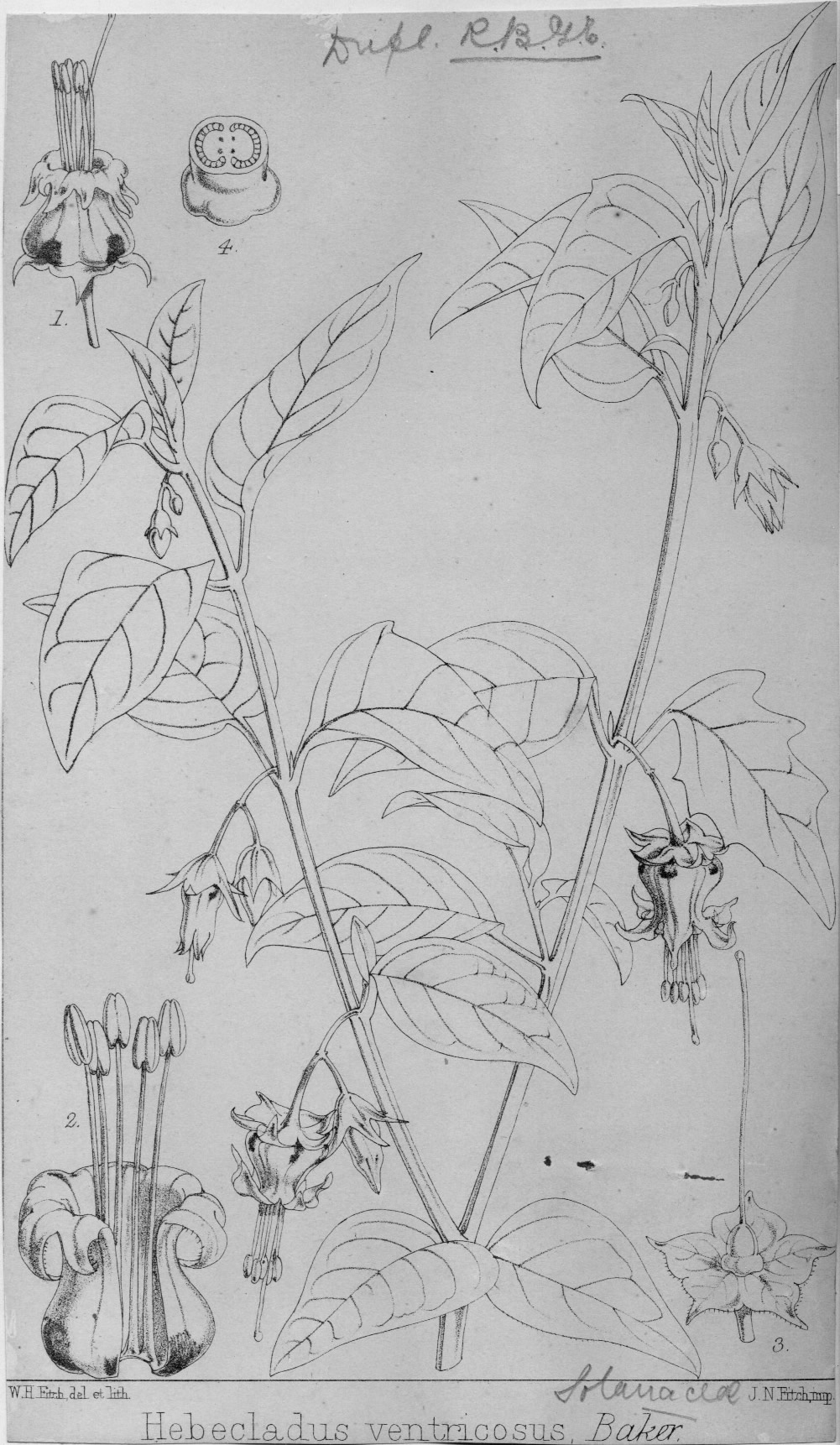 |
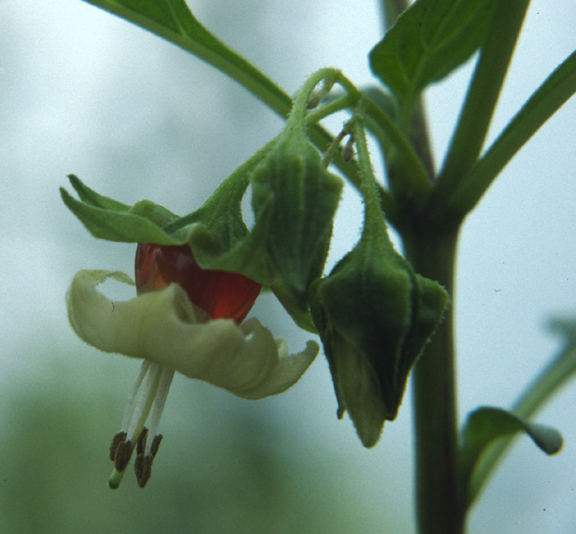 |
Figure 7, at left: Inflorescence Note: The flower bud (on the right) shows the corolla Plant grown in Connecticut USA |
Figure 8, at right: Developmental Sequence: Flowers from left to right are about Note how when a flower begins Units along the top of photo are mm. Flowers on glass to prevent shadow, |
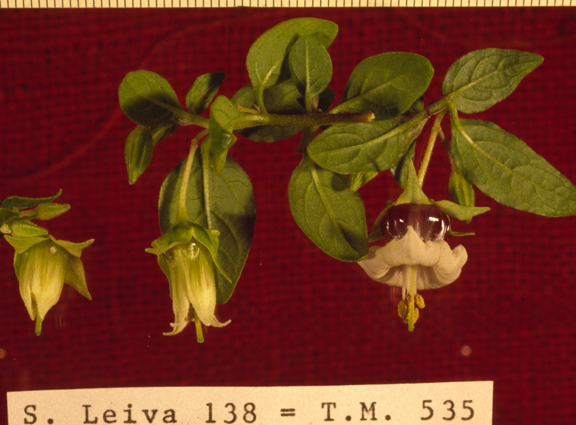 |
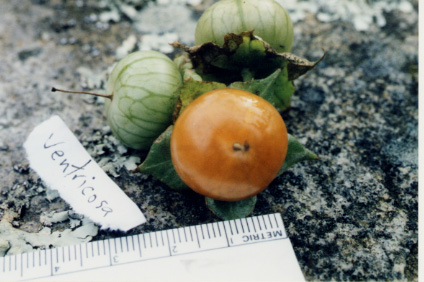 |
Figure 9. Fruit Photo taken in Peru by T. Mione More photos of this species can be seen |
| Figure 10. Ventral view of anther on left. Dorsal (outer) view on right. Units on right are mm. Photo by T. Mione of anthers from a plant grown outdoors summer and fall of 2017, Mione et al. 867. |
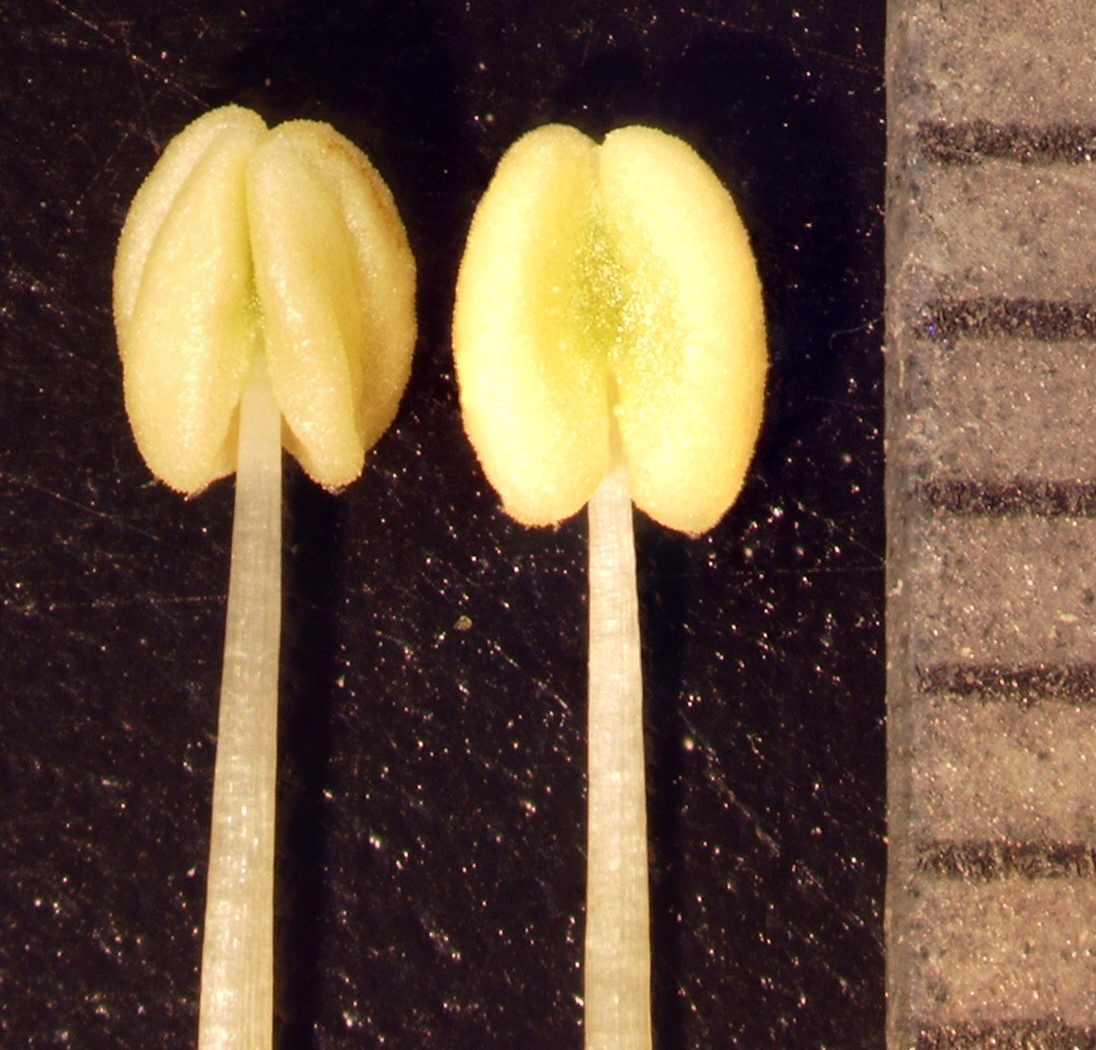 |
Nectar volumes and sugar concentrations for J. ventricosa.
| mm of nectar in microcapillary tube | microliters of nectar | dilution with water if any | raw refractometer reading if applicable | Sugar concentration | Date | Temperature | Refractometer | Previous Nectar Removal* | Humidity |
| 178 | 68.5 | no dilution | 11.3 | 14 September 2017 | 26 C | Milwaukee MA871 | not by a person | 60% | |
| 88 | 33.9 | 1:1 | 6.0 | 12 | 14 September 2017 | 26 C | Milwaukee MA871 | not by a person | 60% |
| 225 | 86.6 | no dilution | 10.8 | 14 September 2017 | 26 C | Milwaukee MA871 | not by a person | 60% | |
| 125 | 48.1 | 1:1 dilution | 5.5 | 11 | 14 September 2017 | 26 C | Milwaukee MA871 | not by a person | 60% |
| 145 | 55.8 | no dilution | 11.1 | 14 September 2017 | 26 C | Milwaukee MA871 | not by a person | 60% | |
| 151 | 58.1 | no dilution | 11 | 28 October 2017 | 16 C | Bellingham & Stanley 45-81 | not by a person | not recorded |
Each row in the above table contains data for one flower, harvested from a plant grown outdoors in Connecticut.
*Given that the plants were grown outdoors, it is possible that nectar was removed by a floral visitor prior to this measurement.
Floral visitors/pollinators had not been excluded.
Nectar appeared orange to light-orange in the microcapillary tubes.
Flowers were of unknown age but were all in the hermaphroditic phase and thus none of the flowers sampled were day 1 (pistillate-phase) flowers.
Mione et al. 867
The plant was in a pot that was burried about 4/5 in the ground. By the dates these measurements were made, the plant almost certainly rooted through the bottom of its pot into the ground. The plant was irrigated on a daily schedule all summer, but did not grow well in the summer heat.